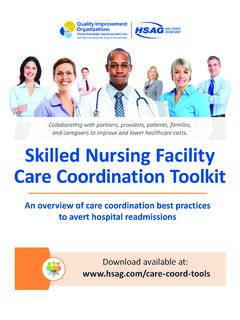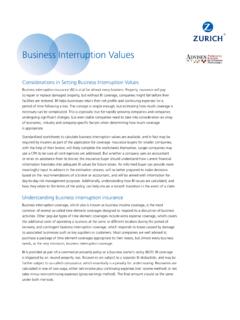Transcription of Care Coordination Best-Practices Toolkit - HSAG
1 Care Coordination Best-Practices ToolkitCollaborating with partners, providers, patients, families,and caregivers to improve and lower healthcare overview of care Coordination best practices to avert hospital readmissionsDownload available at: | 1 Table of Contents Executive Summary .. Organizational Assessment .. Five Key Areas Known to Reduce Avoidable Readmissions .. Typical Failures in Discharge Planning .. Organizational Assessment Summary and Sample .. Admission Assessment Tool .. Discharge Observation Tool .. Preparing for Change .. Five Whys Tool for Root Cause Analysis .. Goal Setting Worksheet .. Strategy Tree Form and Readmission Reviews.
2 Interview with Patients, Family Members and Care Team Members .. 7- Day Readmission Checklist and Audit Tool and Instructions .. Medication Management .. Reducing Adverse Drug Events .. Reducing Anticoagulants Adverse Drug Events Warfarin .. High-Risk Medications: Resource of the Month Warfarin .. Reducing Diabetic Agents Adverse Drug Events .. High-Risk Medications: Resource of the Month Diabetes Education .. Reducing Opioid Adverse Drug Events .. High-Risk Medications: Resource of the Month Opioid Prescribing .. Page | 2 Teach-Back .. Teach-B ack Can Help .. Practice Using Plain Language .. Teach-B ack Sentence Starters .. Teach-B ack Employee Validation.
3 Patient Education Tools .. Heart Failure Self-Management Plan .. My Plan to Identify Infection and/or Sepsis .. COPD Self-Management Plan .. Skilled Nursing Facility .. Skilled Nursing Resident Rehospitalization Tip Sheet .. Guidelines for Customizing the Nursing Home Brochure Frequently Asked Questions .. Skilled Nursing Facility Brochure Template .. Pre-Admission Huddle .. Behavioral Health .. Behavior Health National Resources .. This material was prepared by Health Services Advisory Group, the Medicare Quality Innovation Network-Quality Improvement Organization for Arizona, California, Florida, Ohio, and the Virgin Islands, under contract with the Centers for Medicare & Medicaid Services (CMS), an agency of the Department of Health and Human Services.
4 The contents presented do not necessarily reflect CMS policy. Publication No. Exe cutive S ummary Page | Executive Summary Reducing preventable 30-day hospital readmissions is a priority for the Centers for Medicare & Medicaid Services (CMS). Prior research has shown that nearly one out of five hospital discharges resulted in a readmission within 30 Hospital readmissions are costly both financially and in terms of patient satisfaction. Recent data from Health Services Advisory Group (HSAG) indicates that averted hospital readmissions save the Medicare Trust Fund $12,831 per Hospitals are not the only entity to receive financial penalties for readmissions. Skilled nursing facilities (SNFs) have recently been included in readmission penalties based on performance metrics as of October 1, Despite these penalties, readmission rates continue to be high.
5 CMS views hospital readmissions as a quality indicator for care Coordination . We know organizations like yours are committed to ensuring that patients have the necessary tools and care in place prior to discharge. These efforts provide patients the opportunity to heal in the home setting with loved ones while improving organizational quality metrics. As your CMS Quality Improvement Organization (QIO), HSAG is committed to improving the quality of care delivered in each state we serve. HSAG has met with providers across this state and nationally, identifying tools that will aid you in the work of improving care transitions and Coordination across the continuum. Many of these tools have been included in this book to serve as a guide to readmission prevention.
6 We hope this information will help you and your organization improve care Coordination efforts and result in reduced avoidable hospital readmissions. For assistance or further information, please reach out to your HSAG care Coordination office. You can also find additional helpful tools on each state s webpage. State Telephone Tools Webpage Arizona -tools California Florida Ohio Find more about care Coordination at: Nationally, readmissions cost Medicare $26 billion dollars annually, of which $17 billion are potentially : S, Williams M, Coleman E. Rehospitalizations among Patients in the Medicare Fee-for-Service Program. N Engl J Med 2009; 360 : Available at Accessed March 11, 2019.
7 Average cost of a readmission across Arizona, California, Florida, and Ohio for Medicare Fee-for-Service (FFS) beneficiaries. Data Source: CMSM edicare FFS Part A data Q3 2017 Q2 2018. The Skilled Nursing Facility Value-Based Purchasing Program (SNF VBP). 2018. Available at Accessed March 11, 2019. J. Medicare Fines 2,610 Hospitals In Third Round of Readmission Penalties. Kaiser Health News. Accessed March 11, 2019. Organizational Assessment Page | Organizational AssessmentThis section provides guidance as you evaluate the current state of your organization s readmission prevention strategies. It is crucial to understand the processes that are in place as readmission strategies are introduced.
8 An essential primary step is to identify members of the team who will focus on reducing readmissions. This section provides guidance on evaluating the organization, as well as evaluating admissions and discharges to identify gaps that may be present. Overview of Resources Form Purpose Rationale Page Five Key Areas Known to Reduce Avoidable Readmissions This document provides an overview of the common causes of preventable readmissions. As each organization begins to look at readmission prevention, it is important to recognize common themes that have been proven to improve readmissions. Typical Failures in Discharge Planning This document provides an overview of breakdowns that may lead to a preventable readmission.
9 Readmissions often stem from breakdowns in discharge planning. Identifying these areas will ensure strategies may be implemented to improve care transitions and prevent readmissions. Organizational Assessment Summary (Completed template included) This document provides an overview of current processes in place as well as the current state of readmission prevention strategies. Conducting a thorough assessment of the organization s data and routine practices will aid in identifying areas that meet patient needs, and those that need improvement. Admission Assessment Observation Tool This document provides guidance/evaluation of the admission process. Evaluation of the organization s assessment practices will illuminate areas that need improvement.
10 Discharge Observation Tool This tool evaluates the discharge process. Evaluation of the patient s hospitalization course will provide insight of sound clinical practices and areas of opportunity. Identifying areas of opportunity will provide a framework for readmission prevention work. Find more care Coordination tools at: Never trust to general impressions, my boy, but concentrate yourself upon details. Arthur Conon Doyle The Adventures of Sherlock HolmesPage | 1 Five Key Areas Known to Reduce Avoidable Readmissions Your organization and others across the care continuum are called upon to focus on five key areas known to reduce avoidable readmissions. By implementing and spreading these best practices, organizations can become more effective more rapidly in reducing avoidable hospital readmissions.







